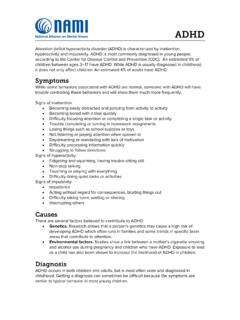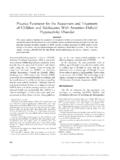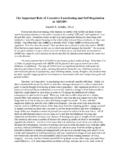Transcription of Evidence-based guidelines for the pharmacological ...
1 519509. research-article2014. of PsychopharmacologyBolea-Alama ac et al. Review Evidence-based guidelines for the pharmacological management of attention deficit hyperactivity disorder: Update on Journal of Psychopharmacology recommendations from the British 1 25. The Author(s) 2014. Reprints and permissions: Association for Psychopharmacology DOI: Blanca Bolea-Alama ac1, David J Nutt2, Marios Adamou3, Phillip Asherson4, Stephen Bazire5, David Coghill6, David Heal7, Ulrich M ller8, John Nash9, Paramalah Santosh10, Kapil Sayal11, Edmund Sonuga- Barke12 and Susan J Young2 for the Consensus Group Abstract Attention deficit hyperactivity disorder (ADHD) is a common condition with a high societal burden.
2 The present guidelines summarise current literature, generating expert consensus recommendations for the treatment of ADHD in children and adults. These guidelines also provide a review of recent research in the fields of neuroimaging, neuropsychology and genetics of ADHD. Novel discoveries in these areas have informed physiological models for the disease. Since the publication of the previous British Association for Psychopharmacology guidelines in 2008, new drugs have been licensed and further compounds are being investigated. The publication of randomised controlled trials of psychological interventions has contributed to the range of treatment options for ADHD. As the disorder has been diagnosed more frequently there has been greater focus on comorbid conditions and how they impact treatment .
3 Services have continued to develop for the treatment of ADHD in adults and care agreements have been introduced to facilitate access to treatment . Keywords ADHD, attention deficit and hyperactivity disorder, hyperkinetic disorder, BAP, ADD. Introduction The British Association for Psychopharmacology (BAP) psychologists, paediatricians, pharmacists, commissioners and encompasses psychiatrists, psychopharmacologists and pre- user representatives. The guidelines encompass a comprehen- clinical scientists interested in studying the effects of drugs on sive assessment of current literature on ADHD, ranging from the brain. Since its foundation in 1974 the BAP has aimed to aetiological research and neuroimaging to current trends in the bridge the gap between experimental research and the develop- development of treatment and services.
4 Ment of new treatments for psychiatric illness. The publication of guidelines on different topics including depression, anxiety disorders and attention deficit hyperactivity disorder (ADHD) 1 University of Bristol, Bristol, UK. 2 Imperial College, London, UK. is a crucial part of this commitment to translate scientific evi- 3 South West Yorkshire Trust, Wakefield, UK. dence into diagnosis, treatment recommendations and service 4 Institute of Psychiatry, London, UK. provision. 5 Norfolk and Suffolk NHS Foundation Trust, Norwich, UK. 6 University of Dundee, Dundee, UK. 7 RenaSci Consultancy Ltd, Nottingham, UK. Who are these guidelines for? 8 University of Cambridge, Cambridge, UK. 9 Mental Healthcare UK, Denbighshire, UK.
5 In line with the general aims of the BAP guideline series, these 10 Centre for Interventional Paediatric Psychopharmacology, London, UK. guidelines are intended to translate recent research in the field of 11 University of Nottingham, Nottingham, UK. ADHD to promote improvements in diagnosis and treatment of 12 University of Southampton, Southampton, UK. this disorder. These guidelines are aimed at all those who deliver clinical Corresponding author: care, commission treatment or are otherwise involved in the Blanca Bolea, University of Bristol, Dorothy Hodgkin Building, Whitson diagnosis and treatment of children, adolescents and adults Street, Bristol, BS1 3NY, UK. with ADHD, including psychiatrists, general practitioners, Email: Downloaded from at University of Bristol Library on February 15, 2014.
6 2 Journal of Psychopharmacology . Table 1. Categories of evidence and strength of recommendations. Strength of evidence and recommendations Categories of evidence for causal relationships and treatment The categories of evidence for causal relationships and grading Ia: evidence from meta-analysis of randomised controlled of recommendations used in these guidelines follow the method- trials ology of the North of England Evidence-based Guideline Ib: evidence from at least one randomised controlled trial Development Project (Centre for Health Services Research, IIa: evidence from at least one controlled study without University of Newcastle upon Tyne and the Centre for Health randomisation Economics, University of York).
7 IIb: evidence from at least one other type of quasi-experi- Recommendations are rated A to D according to category of mental study evidence . A lower rating implies a less extensive or robust body III: evidence from non-experimental descriptive studies, such of evidence but not necessarily lesser clinical importance. The as comparative studies, correlation studies and case- category S represents a standard of care, which describes a con- control studies sensus based on good practice standards rather than evidence . IV: evidence from expert committee reports or opinions and/. or clinical experience of respected authorities Categories of evidence for observational relationships Brief summary of historical context of I: evidence from large, representative population samples previous and current guidelines II: evidence from small, well-designed, but not necessarily The previous BAP guidelines for treatment of ADHD were pub- representative samples lished in 2007 with the main focus on the transition between ado- III: evidence from non-representative surveys, case reports lescence and adulthood, diagnosis and treatment of ADHD.
8 IV: evidence from expert committee reports or opinions and/. beyond the adolescent years. At that time there were no published or clinical experience of respected authorities European guidelines for ADHD in adults, and the 2007 guide- Strength of recommendation lines provided a benchmark for the development of clinical ser- A Directly based on category I evidence vices. They constituted a comprehensive reference source for Directly based on category II evidence or extrapolated clinicians wishing to establish Evidence-based clinics for the from category I evidence treatment of ADHD in adults, and provided an independent sci- C Directly based on category III evidence or extrapolated entific perspective on all facets of ADHD including symptoms, from category II evidence diagnostic criteria and treatment .
9 D Directly based on category IV evidence or extrapolated In 2008 the National Institute of Clinical Excellence (NICE). from category III evidence in the United Kingdom completed a full review of the diagnosis S Standard of clinical care and treatment of ADHD across the lifespan, and published guide- lines for the diagnosis and management of ADHD in childhood, adolescence and adulthood. These guidelines were a significant Brief summary of consensus method stimulus for the development of improved service provision for These guidelines were arrived at by consensus during a one- ADHD in the UK. Similar guidelines published in Germany day conference of a group of nationally recognised experts in a (DGKJP, 2007) and Canada (CADDRA, 2011) had comparable wide range of aspects of ADHD in children, adolescents and effects in their respective countries (Seixas et al.)
10 , 2012). A further adults. This meeting was in part sponsored by Janssen, Lilly detailed review and European consensus statement was also pub- and Flynn-Pharma but represented the independent views of lished by the European Network of Adult ADHD (ENAA), the participants. Contributors received no fee or honorarium (Kooij et al., 2010). Despite this increased interest there is still a for participation. The guideline group included psychiatrists, scarcity of services, particularly adult services, for those with psychologists, pharmacists, recognised clinical and preclinical ADHD. researchers in the field and user representatives. Observers The proportion of the population receiving treatment for from pharmaceutical companies were invited to attend to pro- ADHD in the UK and other Western countries is far lower than vide clarification in terms of unpublished data from clinical the estimated population prevalence of the disorder (I).








